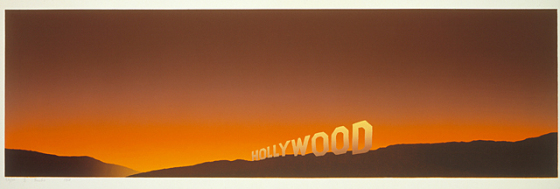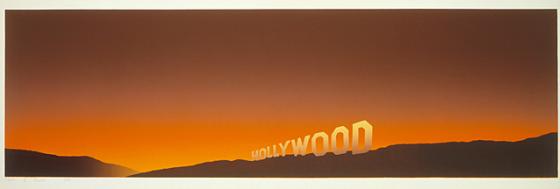Very little is known about the artist Robert Witt Ames, much less his connection to Hollywood. He spent much of his youth abroad due to his father stationed overseas in the army, but returned with his family to Los Angeles in his teens and continued his education locally pursuing a degree in law. But like many of the residents who live in this town, Ames became charmed with one of the largest industries in the area: the business of making movies. If you ever take the BCAM escalator to the third floor floor and look at the view of the hills at LACMA, you can see this familiar sign off into the distance on a clear day:
 Ed Ruscha, Hollywood, 1968, Museum Acquisition Fund, © Edward Ruscha
Ed Ruscha, Hollywood, 1968, Museum Acquisition Fund, © Edward Ruscha
In the American Art Galleries on the third floor of the Art of Americas Building, you can also a see a different version of Hollywood. Artist Robert Witt Ames created a relief mural carved in wood depicting all aspects of the film industry:
 Robert Witt Ames, Hollywood, gift from the Estate of Barbara Carol Weston, sister of Robert Witt Ames, © Estate of Robert Witt Ames
Robert Witt Ames, Hollywood, gift from the Estate of Barbara Carol Weston, sister of Robert Witt Ames, © Estate of Robert Witt Ames
Created in 1935, Ames’s Hollywood features many facets of the movie business. Given that Ames was a film prop maker by trade, it’s clear his experience on studio sets is reflected in this carved relief. While some of the scenes in this mural are pretty easy to deduce—large musical dance scenes, paparazzi, songwriters, and set design to name a few—there were a couple scenes that I found peculiar. I was especially curious about the long line of characters on the bottom left of the mural, as well as the woman lounging on a sofa on the right edge of the carving with a group surrounding her. Around them are the words “never drinks,” “never smokes,” and “hates publicity.” To find some answers, I solicited help from the Academy of Motion Pictures and Sciences (whose museum will be our future neighbor). Anne Coco and Stacey Behlmer from the Margaret Herrick Library had this to speculate:
 Robert Witt Ames, Hollywood (detail), gift from the Estate of Barbara Carol Weston, sister of Robert Witt Ames, © Estate of Robert Witt Ames
Robert Witt Ames, Hollywood (detail), gift from the Estate of Barbara Carol Weston, sister of Robert Witt Ames, © Estate of Robert Witt Ames
While it appears to have been a line for extras, or maybe a line to pick up paychecks (since the window was so tiny), the librarians at AMPAS suspect it to be a casting office. Everyone is lined up in various costumes; some even appear to be coming off a bus. They also noted that the payroll offices would have looked more like a standard office with multiple windows and lines of people arranged alphabetically by last name.
Here was another puzzling scene:
 Robert Witt Ames, Hollywood (detail), gift from the Estate of Barbara Carol Weston, sister of Robert Witt Ames, © Estate of Robert Witt Ames
Robert Witt Ames, Hollywood (detail), gift from the Estate of Barbara Carol Weston, sister of Robert Witt Ames, © Estate of Robert Witt Ames
While I had initially thought this scene reflected some type of starlet with a diva-like attitude, the Coco and Behlmer infer this scene could be related to the enforcement of the Motion Picture Production Code (also known as the Hays Code) instilled in the early 1930s shortly before this mural was created. Designed to regulate the increasing amount of sex and violence depicted in films, and in addition, studios also had morality clauses embedded in actors’ contracts to prevent their personal behavior from affecting movie publicity. The Production Code was eventually abandoned by the Motion Pictures of Association of America in 1968 in favor of a movie ratings system that we still use today.
I could go on and on since there are so many details in this fascinating work (bonus points to those that spot the animated characters), but it’s better to see this large mural up close in the American galleries. Feel free to list your sightings in the comments section!
Devi Noor, Curatorial Assistant, American Art



